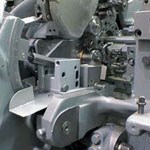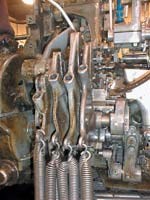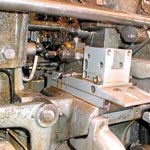Relief For Sloppy Slides
Few screw machine shops can escape the inevitability of tighter tolerance demands from customers. Getting the most accurate tool travel from a screw machine is a key component to consistent part production.
Few screw machine shops can escape the inevitability of tighter tolerance demands from customers. Getting the most accurate tool travel from a screw machine is a key component to consistent part production.
Such is the case for most Davenport users who are familiar with the need to continually adjust the gibs on the company's machines to allow for the constant wear that occurs on the conventional bronze tapered gib. Since operators typically over-tighten the gib to try to reduce chatter, it is also common to see a slide with several springs hanging on the lever. This makeshift solution is meant to help prevent the slide from sticking forward. Another solution is to rebuild the slide. However, this process of scraping the slides can be a time- consuming and tedious task. It is also a difficult process to master, and few know how to perform this dying skill.
Featured Content
A new reversible slide from C.J. Winter Machine Technologies Inc. (Rochester, New York) eliminates the need for regrinding or scraping. The company's model 132-EG is a reversible cross-slide that fits Davenport five-spindle automatic screw machines and extends the machine's range of application and productivity.
The slide uses a precision-fit dovetail expansion gib to replace the traditional bronze tapered gib, which not only reduces or eliminates chatter by making the slide more rigid, but it also allows for heavier forming cuts. Because it fits both the A and B positions, the slide reduces the need for the shop to keep two types of slides in stock. This can represent a reduction of spare parts inventory and expenses by 50 percent. If the shop has many Davenports, that inventory savings alone can have significant impact.
The 132-EG slide uses a plastic laminate-coated expansion gib and a precision match-ground steel slide. Both the slide and base are hard plated. After an initial run-in period in which the plastic laminate "takes a seat" to conform to the mating parts, further need for adjustment is reduced.
An example of successful use of these reversible slides comes from John Golden of PEM Fastening Systems (Winston-Salem, North Carolina). He cites an improved ability to form up to the bar capacity of the machine at greater widths and most important, with no chatter. "The slides installed easily and in both cases eliminated our chatter problems," Mr. Golden says. The company found similar results with the fourth position slide.
Dave Tuttle of Gates Albert Inc. (North Chili, New York) has also been pleased with the results that followed use of the new slide. "Tool life is better because we can use harder tools. There is no sympathetic chatter in the end working tool, and side wear on tools is greatly reduced," he says. Now, the company no longer shies away from larger stock sizes because of rigidity problems. "After proving the slides' worth on older model Bs, the new Davenport Model B Servo is equipped with EG slides all around," he adds. This feature helps the company make maximum use of the versatility of the Model B Servo.
The expansion gib is now standard on the model 131-SA adjustable fourth position tool slide, another product from C.J. Winter. Older-style 130-SA slides can be reconditioned and retrofitted in Davenport's plant for less than the cost of a new slide.
RELATED CONTENT
-
The Evolution of the Y Axis on Turn-Mill Machines
Introduced to the turn-mill machine tool design in about 1996, the Y axis was first used on a single-spindle, mill-turn lathe with a subspindle. The idea of a Y axis on a CNC originated from the quality limitation of polar interpolation and the difficulty in programming, not from electronic advances in controls or servomotor technology as one might commonly think.
-
Understanding CNC Collet Chucks
Workholding for turning is usually fairly basic: The selection comes down to chucks or collets. This article looks at when to consider the collet chuck and what kind might be best for a given application.
-
New Line of Swiss-Types for Job Shops Eyeing High-Production Work
Mazak now offers the Syncrex line of Swiss-type CNC lathes — its first — targeting machine shops getting into higher volume production of complex parts.









